Earth 2160

| a game by | REALITY PUMP Sp. z o.o. |
| Platform: | PC (2005) |
| User Rating: | 9.0/10 - 2 votes |
| Rate this game: | |
| See also: | Best RTS Games |
Real-Time strategy games can be very hardcore and Earth 2160 is living proof. If you've missed previous instalments in the series, you might be forgiven for thinking it's just another generic realtime strategy game, following on from Command & Conquer, the granddaddy of them all. Scratch below the surface though, and you'll quickly find yourself drowning in a sea of options.
Of course Earth 2160, like its predecessors 2140 and 2150, does stick very much to the traditional RTS template. You begin each mission in the corner of a map, with some prime real estate from which you must establish a base of operations. Once you've established the all-important command centre, you need to gather all the resources that will enable you to amass the necessary units, and then send them in en masse against the enemy. Hopefully, following some indeterminate time and after repeating the build and attack cycle, a victory is achieved and it's onto a new map. Then just rinse and repeat, as they say.
However, whilst other strategy games tend to drip feed you units and new technology, Earth 2160 quickly unleashes a torrent of building options. There are four different sides, each with the traditional handful of base units. However, open up the research tree and put a couple of labs to work, and before too long hundreds of permutations become available. All told, over 10,000 different units can be created -probably more than you would ever need.
Production Line
How it works is pretty straightforward. Take charge of the Eurasian Dynasty, for example (neo-Communist, ruthless, rather likeable), and in order to build a basic recon vehicle you must first erect a Production Centre. So far, no big deal - you can chum out bog-standard vehicles until the cows come home (or until the unit ceiling is reached, which at this stage is likely to be sooner). However, tack a research lab onto your expanding HQ and things get more interesting, as you can browse the sinuous research tree.
In the campaigns, the initial selection is rather thin, but even so, the upgrade options are quite extensive compared with other like-minded games, with a number of general improvements to armour, engine and weapons that can be researched. Once they are, you then slip into the Construction window, select the chassis and add in your newly researched modules. A few minutes into a mission then, and that recon buggy can quickly be adapted to take on small bands of infantry, tanks, aircraft or even spearhead a base assault - so long as you remember to slap on that new armour and stealth shielding you've had your technicians working on.
Lick My Reality Pump
Of course, the s 4 problem with all this design work is that you spend so long constructing new vehicles that you neglect the fisticuffs, and as your first Mega-Mondo-Killer Robot Of Death Mk III' rolls off the production line (yes, you can name your units however you like), the enemy will be battering your defences with dozens of bog-standard recon trucks.
And that's the great thing about Earth 2160- other games allow you to build elaborate defences, hoard resources and research new technologies, but Earth 2160 expands the concept so far in each and every direction that the potential for strategic mayhem seems almost limitless. Where most RTS games are lacking in either resource management or in the breadth of units, here you have both taken to extremes. Earth 2160 really does go all the way to 11.
Like I say, there is a downside to all this, that you lose sight of the battles as you try to work out which combination of modules works best for any given situation. Dive into the skirmish game first and I guarantee you'll be swamped and ultimately frustrated. Thankfully, the campaigns gently lead you up to the big guns.
Bedtime Story
As much as the sci-fi story follows on from the previous games, it's not one that requires a great deal of explanation. The Earth is no more, destroyed by a war started by the Eurasian Dynasty and returned in kind by the Lunar Corporation and the United Civilized States. Now searching for a new home, humankind has carried the conflict over to Mars, and it's here that the war continues unabated - the UCS having mysteriously been populated entirely by robots. There's also a fourth race now, a strange alien civilisation, one that relies not so much on an expansive network of buildings to operate, but resources to clone and morph into new units.
I'll be honest and say that while the developer has tried hard to create a story for the game, it doesn't carry itself particularly well. Partly it's because it's one that's already been flogged to death, but mostly it's due to the fact that the voice-overs for the central characters and the script itself are so overladen with cliche that you'll want to skip through it, despite the more-than-acceptable quality of the in-engine cut-scenes.
Variety Of Strife
The variety between the four civilisations and the way they do battle is compensation enough for the lacklustre narrative. There are three resources in the game; water, metal and crystal, each race requiring just two. This in itself adds a dimension to the battles, for depending on the side you choose and the enemy you face, some areas of the map will be harshly contested, whilst others will not.
Additionally, each side harvests resources in different ways. The Aliens and LC are able to deploy gargantuan mining outposts, the USC use more traditional harvesters and static refineries, whilst the ED favour a cunning hybrid of the two. Moreover, the ways in which bases are constructed are vastly different. Again the USC favour the base-building methods seen in C&C, with power structures having to be planted near buildings to keep them juiced. ED installations have to be linked with cylindrical connecting pipes, yet are able to erect strong defensive walls, while the Lunar Corp, on the other hand, have mobile buildings that extend upwards, guarded by power fences. The mysterious aliens require no base at all. How you approach each base, whether building or destroying it, will be different in each case.
Lead From The Front
Despite the hundreds of permutations of units that can be conscripted, having to endlessly mine in order to replenish lost units can quickly become a bit of a chore. For obvious reasons it pays to keep your units alive more so now that combat experience can be a decisive resource in and of itself.
Units that manage to pull off successive kills become increasingly lethal, with the longest-serving units able to dish out and soak up twice as much punishment as a fresh recruit. Experience carries over between missions as well, so while you can happily send your units into certain death situations, as the campaign nears conclusion, you'll wish you hadn't been so hasty in sending your young men/ women/robots/ahen things to their doom.
Unsurprisingly, given the developer's obvious intent in borrowing almost every RTS innovation of the past decade, Earth 2160 also features a number of hero characters and 'virtual agents', the latter being mercenary special units that become temporarily available from time to time. Heroes on the other hand are a central focus of your campaign, as they not only ground the story, but must survive in order to secure victory. Unlike the useless Kings that feature in the likes of Age Of Empires however, heroes in Earth 2160 are required to wade into the thick of the action, able to pick up and use weapons and items that may be left lying around. They too gain in experience, which is not inconsiderable since these guys are pretty lethal to begin with.
More Is More
OK, I'll be honest with you. I've never been a fan of the Earth games until now. I've always found them to be too... for want of a better term, German. (Yes, I know the developer is Polish, but the game is ostensibly of Teutonic origin.) Not that I've anything against Germans, you understand. I lived there for a while in my youth, I have German blood in my veins and it's a country that produces some fine beers - far better than any English concoction (and don't forget Kraftwerk -Ed). But it's been a trait of games born with the German market in mind that they've been loaded with tons of features, the more the merrier, often to the detriment of the actual gameplay.
Thankfully, I can report that while Earth 2160 continues in much the same manner, and can be overwhelming for some players (it has a mind-boggling, almost stupid number of keyboard shortcuts, for example), the series has acquired what might be called the X-factor - even when you're facing defeat, a game can still be captivating. The graphics certainly go some way to adding to the tension and atmosphere, for simply zooming around watching the battles has its own rewards.
Away from such shallow concerns, however, Earth 2160 has a great deal of depth to it that is sure to take countless weeks to uncover.
You've Got To Work
There are concerns, of course. The ability to see through the eyes of your units in first-person is a pointless and diverting feature - although thankfully it's not a requisite to victory. Graphically the game is rich with detail, but the animation isn't nearly as frenetic as, say, Dawn Of War. The Al is solid if unspectacular - each side does play to its strengths and will advance and retreat in a consistent manner, but when handed an advantage, enemy forces will rarely take it.
Bizarrely, the greatest advantage of the game is also its greatest failing; that in offering so much choice and variety, it lacks the frenzied accessibility of the games it so obviously tries to build upon. If you're not prepared to put in the effort. Earth 2160's depth will either pass you by or utterly drown any enthusiasm. As Total Annihilation did all those years ago, Earth 2160 takes real-time strategy gaming to an extreme that is in turn both exhilarating and overpowering. You have been warned. And if that hasn't put you off, then I'm sure you'll lap it up.
Let Me Look Upon You With My Own Eyes
The Caps Lock key is not one you will use very often (unless you bind it to quick-save your game). By default it changes the view from one that enables you to get an overview of the terrain, to one that allows you to see through the eyes of the currently selected unit. Indeed, while it's initially entertaining to see your soldiers fight toe-to-toe, it serves little purpose. Veterans who remember Battlezone (no, not the arcade game) will remember that the first-person perspective was an integral part of the game, as by controlling your units you had a profound effect on their abilities. Here it is simply a gimmick, and even though you can elect to have the view relegated to a picture-in-picture window, it still serves little purpose beyond making screenshots look good.
Download Earth 2160

System requirements:
- PC compatible
- Operating systems: Windows 10/Windows 8/Windows 7/2000/Vista/WinXP
Game Reviews
Place: A Stiflingly hot mini-cinema in the depths of London. Time: losing track of. Event: the premier showing of the new Earth 2160 RTS.
As I struggle to hear the incoherent mutterings of two pasty developers over the deafening orchestral soundtrack, stunning sci-fi images of beautifully desolate landscapes, intricate pulsating techno-cities and dozens of cybertroopers storming into laser-battles flash across the large projection screen. Feeling a little disorientated, I am suddenly compelled - after being bombarded by this Clockwork Orange-esque display for 20 minutes - to turn around and politely ask the PR bod in the seat behind me, What the fk is going on?
Sanity. The volume is lowered, and finally I have an opportunity to find out more about the latest instalment in the incredibly popular (mostly in Germany) strategy franchise, that began with Earth 2140 in the mid-1990s and continued with an Earth 2150 trilogy that shifted over two million copies. Earth 2160 is actually an odd title, as the action takes place on Mars and other planets and moons in the solar system after our own planet is destroyed. Three earth factions - the female-only (no snickering at the back) Lunar Corporation, the android United Civilised States and the warlike Eurasian Dynasty - storm the red planet in a battle for supre nacy, only in the process, they awaken another deadly force - aliens. Yes, we've all heard this kind of gumph before, but after the initial shock of how god awful the presentation was, the fog of war started to lift and to my utter surprise, an incredibly impressive, futuristic strategy epic was revealed. Enough of being talked at - time to skedaddle back to the office with the only copy of the game for an exclusive hands-on.
Collateral Damage
Cripes. Earth 2160 is immensely complex - the keyboard shortcuts alone would fill a tome heavier than the last Harry Potter. However this is apparently what the developer wants to unleash - a game packed with resource management, massive tech trees with unlimited research, a modular construction system, single-player campaigns and multiplayer, graphics comparable with first-person shooters, and a comprehensive editor that allows you to make maps and your own machinima movies. This is an RTS with nowt taken out.
The main innovations are threefold: virtual agents, modular construction and free research. Virtual agents are similar to the heroes in LOTR: Battle For Middleearth, but with more advanced features than just trainable skills, interpersonal relationships and an inventory. In simple terms, you can hire and fire 12 key agents, who take care of the stuff in the game that you can't be arsed with or have no knowledge of, such as increasing mining efficiency, conducting espionage and researching military tactics. The payoff is that they have a long memory - treat them like a freelancer (bully tactics, denial of food and water, ignoring personal requests, etc) and they won't work for you again, even going out of their way to stab you in the back by whoring themselves out cheaper to your enemies.
On to modular construction, which is basically the ability to create units from a vast collection of parts, enabling you to create custom buildings with different facilities, as well as mechs, vehicles and spaceships with unique purposes. Some buildings can reach six storeys in height -I cobbled together a medical research centre with a pharmacy, hospital, solar panels and research facility in a matter of minutes - and they can also take off and land somewhere else if your base is being threatened by hostiles. Army units can be built with different chassis, engines, armour, weapons and special items, so you can have a spider-bot armed with multiple lasers for frontline assaults, or an anti-grav tank with flame thrower and reflective armour for base defences - it's entirely up to you.
Free research, meanwhile, is exactly that - the ability to work on as many different technologies as you like, as long as you have the resources of research centres, power and money. Tech trees I experimented with included upgrading an infantry unit to a hacker and then master with jetpack for breaking into enemy security systems. I also did a little weapons research for my Ares fighter craft, giving me access to three kinds of sniper rifle and a sonic beam for cutting through enemy forces like French soft cheese.
Target Rich
The non-linear campaign lets you play as all four of the factions across Mars and 13 other worlds with wildly different environments, offering in excess of 150 hours gameplay. You certainly won't finish Earth 2160 over a lazy weekend. Some of the missions revolve around gathering the game's three resources (water, metal, silicon-all available in various physical states including gas and liquid), but there are more gung-ho escapades such as escorting a dangerous prisoner on Titan and defending a research facility from a two-day onslaught on Io.
Drop-down menus help you negotiate the myriad of in-game options and you're always kept up to date with your goals on the mini-map, so you're never left confused about what to do next.
Interestingly, alongside the usual drag-and-drop control mechanisms, the game also offers a real-time mouse-aim feature similar to the recent Soldiers: Heroes of WVVII. While not a vital part of the gameplay, this device is intended to provide a more dynamic, hands-on feel to the battles. Elsewhere, units can be set to automatically engage nearby hostiles so you don't have to baby-sit every element of your forces, but you can also pause the game and give specific orders to individuals or groups of units if you prefer.
Oh look, I'm getting too technical. Earth 2160's overriding wow-factor is the graphics - they're fantastic. The planets themselves have believable rock surfaces, shimmering pools of liquid, erupting geysers, moving skies and enough trees and fauna to give any botanist a chubby. As for the buildings and structures, they're incredibly detailed, organic affairs packed with steaming valves, moving panels, blinking lights, pumping pistons and fast-firing gun turrets. Not forgetting the army units, with shiny spaceships, mechs and vehicles constructed from dozens of colourful and strange metal alloys, and infantry dressed in different uniforms and loaded up with individually-modelled weaponry. Dynamic lighting means that shadows move as the day/night cycle changes (see panel, Let There Be Light), and there's particle effects aplenty with realistic fog, dust that kicks up and weather effects such as acid rain and thunderstorms. Earth 2160 even has a fully-integrated physics system, demonstrated by a mission where you can fire lasers at large rocks to set off an avalanche of debris that rolls down the hill to crush an advancing army.
The camera can be rotated in full 3D, with a cracking zoom function that can view the action from way up high, then move down to within inches of the surface. More impressive still is the ability to take over any unit at any time, directly control it and see the world from a first-person perspective - each type of unit even has a unique HUD! In one memorable sequence, I jumped into a tank at ground level, just in time to watch a marauding squad of Term/nator-style robots and hulking mechs stomp past like a scene straight out of Jurassic Park. Developers Zuxxez and Reality Pump have promised that even though 100 units on-screen is not a problem, the actual total number of units possible is limited only by your PC's hardware.
Drop In, Drop Out
Multiplayer is another area that's being stuffed with extra features, with up to eight players able to engage in battles using the four competing races. Better yet, Earth 2160 will include the ability to save and restore matches, join battles that are already in progress and report on the action with video reporting via web streaming.
With a few months until completion, there are still a few issues to resolve, including the appalling voice acting, which sounds like an eastern European l-Speak-Your-Weight machine (proper Hollywood talent is apparently on the way). See also facial animation, spaceship battles and the occasional crash bug. Yet despite my deep scepticism caused by the earlier nightmare in Soho, Earth 2160 may actually turn out to be one of the strategy highlights of the year. Videogame lesson number 87: never judge a game by its launch event.
Let There Be Light
Earth 2160's Dynamic Lighting Can Be Used In Battle Tactics
Earth 2160 has gorgeous lighting effects - from explosions reflecting off buildings to alarm systems casting swathes of red light onto objects. Day/night cycles mean that you can watch the shadows stretch across the ground as the sun sets (or suns - you can have a Tattooine-style sky if you like) and dusk turns to night.
However, you can also use the lighting to give you a tactical advantage. Each vehicle has lights that you can manually turn on and off, so if you want to attempt a sneaky night raid, simply wait until it goes dark and assault an enemy's base with your lights off to approach completely hidden from sight.

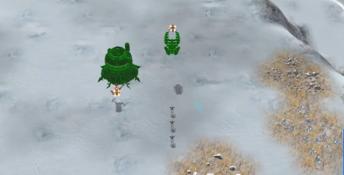
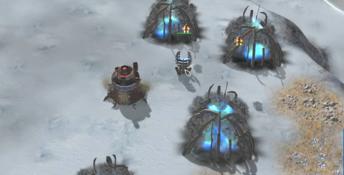
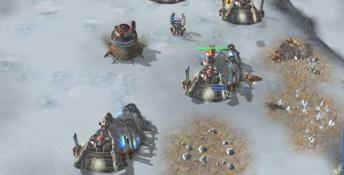
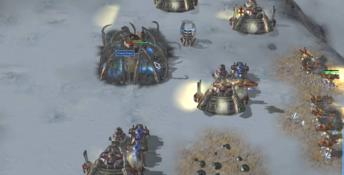
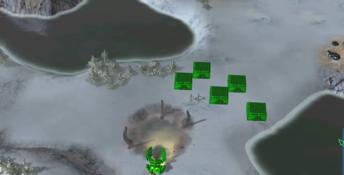
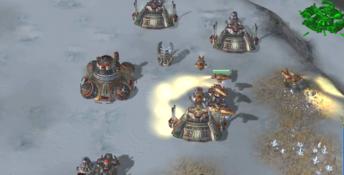
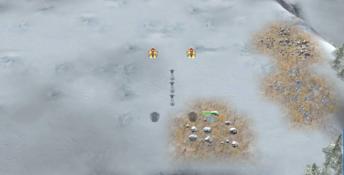

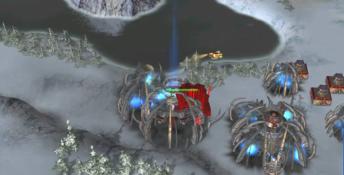

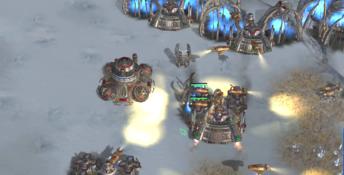
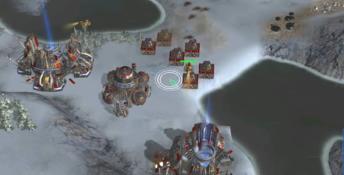
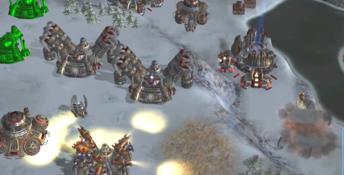
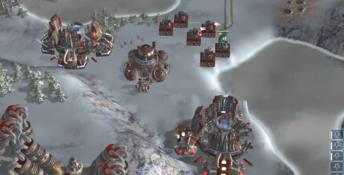
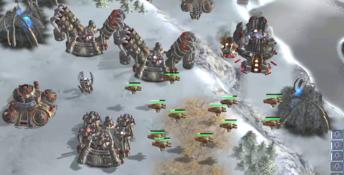
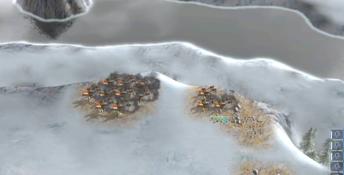
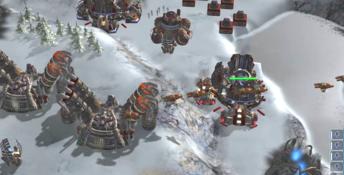
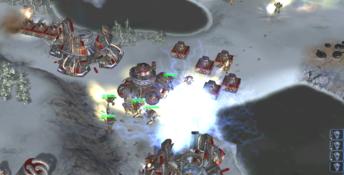

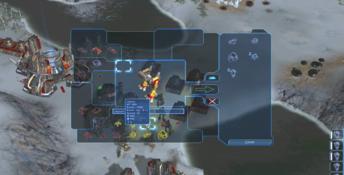
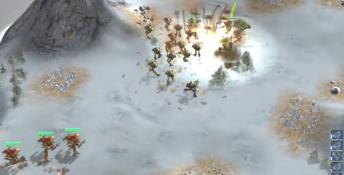
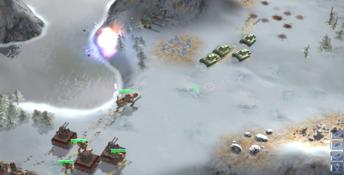
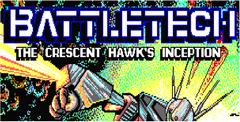 BattleTech: The Crescent Hawks' Revenge
BattleTech: The Crescent Hawks' Revenge
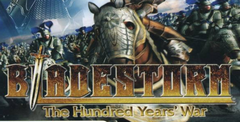 Bladestorm: The Hundred Years
Bladestorm: The Hundred Years Darwinia
Darwinia
 Perimeter
Perimeter
 Seven Kingdoms
Seven Kingdoms
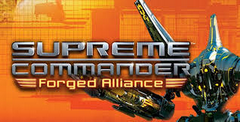 Supreme Commander: Forged Alliance
Supreme Commander: Forged Alliance
 Warlords 4: Heroes of Etheria
Warlords 4: Heroes of Etheria Warlords Battlecry 2
Warlords Battlecry 2
 Will Of Steel
Will Of Steel